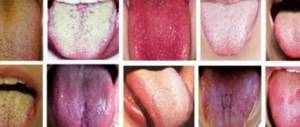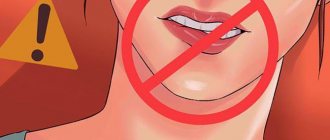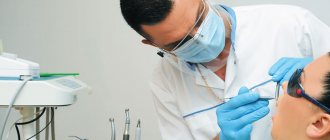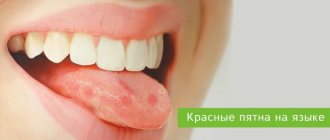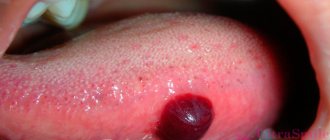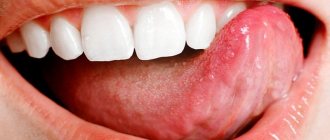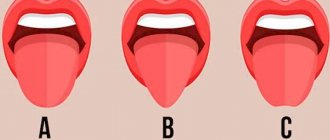The condition of the tongue directly indicates not only the dental picture - any problem that arises in the oral mucosa can reflect pathological processes occurring in the body. The performance of the intestinal tract, the immune response, hormonal surge, metabolic disorders, even changes in the daily diet - all of this in one way or another affects the possible presence of defects on the walls of the tongue, including cracks, ulcers, painful pimples and blisters. What does the presence and degree of cracks on the surface of the tongue indicate, why does such a pathology appear and how to get rid of it at home? A little medical education will help you understand the features of unexpected defects in the oral mucosa!
What is scrotal tongue
A folded (scrotal or grooved) tongue is a genetically determined disease in which this organ has abnormalities in shape, size and surface structure. This disease usually manifests itself in childhood, sometimes from birth. In a child, the grooves are not as pronounced, but the older a person gets, the deeper and more prominent the folds become. By the way, they may not affect the entire organ, but only some part of it.
Interesting! In Latin, the word “scrotum” means “scrotum”, and the tongue is called scrotal because of the similarity of its surface to the skin folds of the scrotum.
Most often, the organ has one longitudinal groove located between the midline of the tongue and its tip. Transverse grooves lead to it, forming a scrotal system reminiscent of the pattern of a large river basin. On the lower part of the organ you can see symmetrical fringed folds.
In accordance with this, the grooves are of several types: fringed, longitudinal (usually the deepest) and transverse (less deep, directed towards the main longitudinal fold).
Localization of cracks
The position of the cracks is not random. Localization is divided into three types, each of which is caused by specific problems. You can independently identify the type of localization by assessing the position of the cracks in the tongue: in the center, on the sides or at the tip.
The presence of cracks only at the tip of the tongue indicates the following causes of the problem:
- Thermal damage. Hot food first comes into contact with the tip of the tongue and causes major damage to it. Often the problem is contact with a hot metal spoon.
- Chemical damage. Occurs from contact with spicy, sour foods or corrosive substances.
- Physical impact. The tip can crack due to an incorrect bite or a cut on the sharp protruding parts of the incisors and canines.
Photo: cracks on the sides of the tongue
The formation of cracks in the tongue in the middle has a different reason, since it is almost impossible to injure this area without touching the periphery. This means that inflammation is an indicator of pathology or disease of internal organs. In addition, the formation of cracks in the center is possible when the middle area dries out, local circulation is impaired, or the immune system is weakened. There may be only one crack; upon examination, it appears as if the tongue has split into two parts.
The presence of cracks on the sides of the tongue can be caused by various reasons. If the inflammatory process is present on the side on one side, then this means physical damage from the sharp edges of small and large molars or dentures. If the tongue is cracked on both sides, it means that there are serious malfunctions in the functioning of the body , where glossitis acts only as an indicator of pathology.
Symptoms of scrotal tongue
The grooves can be either an independent phenomenon or a consequence of another disease, however, in both cases, other symptoms may also be observed:
- increase in size and thickness of the tongue (macroglossia). Sometimes the organ becomes so large that it does not fit in the mouth, which is why the person is forced to keep his mouth slightly open,
- difficulty chewing and swallowing (most often with macroglossia),
- the appearance of furrows on the surface (in children they can be almost invisible, but with age they become more pronounced and deep),
- the appearance of a “pattern” on the surface of the organ, consisting of alternating bright red, pink or whitish areas,
- atrophy of the filiform papillae (the back or tip of the organ becomes smooth),
- the sensitivity of the mucous membrane increases, especially after an infectious disease or surgery,
- tingling, tingling, short-term itching,
- enlargement of the submandibular lymph nodes,
- bad breath.
Use of traditional medicine
At home, you can use well-known methods to help heal wounds in the mouth, eliminate pain, relieve swelling and other symptoms. However, before treating cracked tongue with folk remedies, you need to ensure their compatibility with the prescribed medications.
The most effective are the following recipes:
Herbal infusion of chamomile, celandine, sage and calendula. For adults, you can add St. John's wort. Take after meals in the form of baths or lotions. Promotes wound healing and relieves swelling.- Compresses from fermented milk products. Soften scars and scabs. The procedure should be done in the morning for 15 minutes.
- Sea buckthorn or olive oil. In the morning you need to drop a few drops on the mucous membrane and in the middle of the tongue, then do not drink or eat for 15 minutes. Softens dry formations on the tongue and mucous membranes.
- Honey. Has wound-healing and antimicrobial effects. A piece of the product can be placed in the middle of the tongue and dissolved. Gives a good effect if cracks bleed.
- Propolis tincture (for adults only). The strongest disinfectant: has antimicrobial, antibacterial and anti-inflammatory effects. Since alcohol tincture cannot be used in its pure form if there are open wounds, you need to dilute 1 teaspoon in 100 grams of warm tea. Drink after meals.
Reasons for the appearance of folds
Despite the fact that this condition was described by ancient Greek healers, science still cannot say with certainty where this anomaly comes from. Some scientists consider this a hereditary disease, others – a pathology of intrauterine development, and still others – a consequence of bacterial exposure with weakened immunity.
However, most scientists identify several pathologies that can lead to the formation of a scrotal tongue:
- chronic gastrointestinal diseases,
- skin diseases,
- dysfunction of the hematopoietic organs,
- metabolic disorders, endocrine or nervous systems,
- acute infectious diseases,
- radiation or toxic effects on the fetus,
- mental illness,
- connective tissue lesions (collagenosis),
- malnutrition of the tongue mucosa,
- violent reaction of the body to the vaccine (hyperergy),
- acute deficiency of vitamins and microelements (especially during fetal development and in the first months of life),
- functional changes in the body during pregnancy, menstruation, menopause, etc.).
Geographic fold tongue
Depending on various factors of influence, as well as on concomitant diseases, the nature of the grooves can be of several types. For example, desquamative glossitis, which is sometimes called geographic tongue, is characterized by the presence of reddish or gray spots on the surface of the organ. They come in different sizes and are most often separated by yellowish borders of thread-like nipples. Thanks to this pattern, the organ is similar to a geographical map. Often such “cards” indicate the presence of another chronic disease.
Types of glossitis
In total, there are more than ten types of glossitis, three of which are accompanied by the appearance of cracks in the tongue. They have quite pronounced visible differences. To independently diagnose the type, you can compare the current state of the tongue with photos of classic manifestations of the disease.
Folded glossitis takes its name from the main external manifestation - the presence of folds. Sometimes, with this type of disease, a cracked tongue is present from birth. If it does not hurt, is not loose and there are no other unpleasant sensations, then the condition is considered normal. However, with deep cracks in the tongue, treatment is still necessary.
The problem of a folded tongue is often only of an aesthetic nature, although people with this feature are recommended to have constant monitoring by a dentist.
Desquamative glossitis is characterized by focal damage to the surface with almost imperceptible shallow cracks. The papillae desquamate and a whitish heterogeneous layer forms. The affected areas quickly recover, acquiring a natural color, and those adjacent to them become inflamed. The geometry of white areas (plaque) on the surface often changes. In advanced cases, due to the large number of cracks, a person feels the tongue is loose.
Diamond-shaped glossitis is characterized by the presence of a rhombic or oval-shaped area of red-blue color. It is located in the middle of the tongue, in the region of the posterior third. The tongue cracks in the center, so that the entire affected area seems to be divided into two parts. This type can be chronic, and during exacerbations, pain and burning begin.
Folded tongue with white spots
Sometimes, in addition to the grooves, white spots appear on the organ. Typically, this symptom is observed in several pathologies at once:
- desquamative glossitis,
- Melkersson-Rosenthal syndrome,
- candidiasis glossitis (damage to the mucous membrane of fungal or yeast-like infections, oral thrush),
- leukoplakia (pathological reaction of the mucous membranes to various irritants. Outwardly it looks like a whitish dense spot that can increase in size),
- sclerosing glossitis (begins with tertiary syphilis). The proliferation of connective tissue in this form of syphilis is accompanied by compaction of the organ and a decrease in its mobility, while the scrotal tongue is soft and loose and has good mobility.
Important! Leukoplakia of the tongue is rarely diagnosed; most often the mucous membranes of the inside of the cheeks, palate and angular folds of the mouth are affected. Leukoplakia differs from geographic tongue by compactions in the area of spots (even warty growths) and can develop into malignant formations.
Possible complications
In advanced forms of the disease (if the tongue constantly bleeds, removal of plaque is accompanied by severe pain, there are purulent ulcers), an abscess may form. At the same time, salivation increases significantly, the tongue greatly increases in size, acute throbbing pain occurs, and speech is impaired. A serious complication is the development of phlegmon. Suppuration becomes pronounced, speech and breathing become difficult, the patient refuses to eat, and possible attacks of suffocation. Symptoms of general intoxication of the body become pronounced.
How is the disease diagnosed?
First of all, if grooves appear on the tongue or if it increases in size, you should contact your dentist. He will conduct a visual examination of your mouth. At this stage, it is important to identify the type of pathology and exclude (or confirm) diagnoses in which the same phenomena may be observed.
If a concomitant disease is suspected, the dentist refers the patient to the appropriate specialist - rheumatologist, venereologist, neurologist, endocrinologist, etc. – for additional examination.
Pathological condition
If your tongue bleeds, this may be one of the symptoms of glossitis. Inflammation is caused by viral or bacterial microflora; it can be an independent pathology or accompany some systemic diseases. For example, stomatitis is often caused by the entry or activation of the herpes virus into the body. Mechanical injuries contribute to the development of the disease; smokers and people who abuse alcohol are at risk.
If the tongue bleeds, common causes of this condition are concomitant pathologies: liver diseases (carcinoma, cirrhosis, hepatitis), chronic renal failure, chronic inflammation of the gastric mucosa, intestinal inflammation, peptic ulcer. This symptom is characteristic of intoxication with salts of heavy metals, helminthiases, and vitamin deficiencies.
Drug treatment of folded tongue
Since the causes of grooves are not fully understood, and changes in the mucous membrane are irreversible, treatment can only be symptomatic. For example, for fungal infections, antifungal drugs (sodium tetraborate in glycerin, aniline dyes, antifungal ointments based on imidazole) and/or anti-inflammatory drugs (Miramistin, chlorhexidine), as well as immunomodulators and vitamins are prescribed (for example, applications on the tongue with an oil solution of vitamins A and E).
If infectious lesions of the folds develop (food particles may remain in them, which serve as a breeding ground for bacteria), the doctor prescribes antibiotics, antiseptic rinses or mouth baths (for example, 25 drops of a 1% citral solution in half a glass of warm water).
Surgical treatment of pathology
Surgical intervention in the treatment of the above disease is performed extremely rarely and only in severe cases, when the organ becomes so enlarged that it makes eating, breathing and speech difficult. As a rule, surgeons excise part of it in a wedge-shaped manner.
In some cases, if the folds deepen significantly, they can be sutured, including “smoothing” with a laser. Surgical intervention can also be used for chronic inflammation of the furrows - as a preventive measure to prevent severe infectious lesions. In the postoperative period, the patient is recommended to have speech rest, minimize chewing movements and diet therapy.
Disease prevention
In most cases, this pathology does not bother a person, however, for this to continue, the organ must be looked after. Here are some recommendations for preventing inflammation of the scrotal tongue:
- regular oral hygiene. Microparticles of food can get stuck in the furrows (especially if they are deep enough) and rot. This is a favorable microsphere for the development of various bacteria and unpleasant odors,
- irrigating the tongue or rinsing the mouth after eating with special rinses, herbal infusions, baking soda solution,
- careful care of removable dentures and orthodontic structures, as they hinder the natural cleansing of the mucous membrane,
- exclusion from the diet of spicy, salty, too cold or hot dishes, as they are an additional irritant to the papillae on the mucous membrane,
- quitting smoking and alcohol,
- using a special children's toothpaste and a toothbrush with soft synthetic fibers to clean your teeth to avoid injury to the organ,
- Regular (at least once every 6 months) visits to the dentist.
It is important to know! Insufficient care of the scrotal tongue or ignoring foci of inflammation in it is dangerous for the development of severe infectious lesions (catarrhal inflammation, candidal glossitis, phlegmon, abscess, hyperkeratosis) and even cancer.
FAQ
How to distinguish leukoplakia from a folded tongue?
Leukoplakia has different symptoms from a grooved tongue. It should be taken into account that some of them may appear if the scrotal disease is not properly cared for.
- Inflammation and swelling of the mouth and tongue;
- Horny formations with a white coating;
- Ulcers and erosions;
- Bleeding of the affected areas;
- The mucous membrane of the mouth and tongue becomes denser and harder;
- Rapid growth of painful formations;
- Proliferation of papillae in affected areas.
Can the tongue bend poorly due to folding?
Most often, the scrotal tongue is soft and mobile. If the bending of this organ is poor, you should consult a specialist. This may be a sign of sclerosing glossitis.
Is it possible to use sea buckthorn if you have a folded tongue?
Yes, you can.
Do they die from this?
No. The main thing is to follow all the points of caring for such a tongue, otherwise other infections may arise, which can lead to very serious consequences.
Is folded tongue a disease?
Yes, this is considered a disease, but it does not threaten the owner with proper care.

